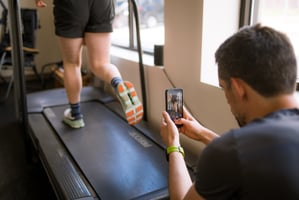(Original Post Date: 9/22/22)
A Runner’s Guide to the Continuum of Running-Related Injuries
What actually is a running-related injury?
In 2015, healthcare researchers created a consensus definition of running related injury.1 They defined injury as “running-related musculoskeletal pain in the lower limbs that causes a restriction on, or stoppage of, running (distance, speed, duration, or training) for at least 7 days or 3 consecutive scheduled training sessions.” Essentially, you are considered injured if you have pain in your legs from running that changes your training for a week or 3 sessions. While this definition provides clarity, injuries are rarely this black and white.
Running-related injuries exist on a continuum, as defined by a recent survey of runners.2 This continuum comprises nine levels, ranging from 'running smooth' to 'career-ending injury’. Fortunately, career-ending injuries are very rare, and most of us find ourselves somewhere in the middle of this spectrum, grappling with persistent pain at the start of runs that often disappears by the end.
‘Running smooth’ is where we all want to be! Here, running feels effortless and pain-free. However, it's easy to become complacent and reactive, rather than proactive, to pain when we're feeling good. This looks like stopping our strength and/or mobility program when we feel good because “That is only for when I am injured.”
Runners recognize that discomfort and niggles are an inevitable part of training. Consequently, we are less likely to see a provider when we experience these issues. It makes sense! Traditional in-network physical therapy clinics wouldn’t be able to do much for us here because insurance won’t approve visits. Luckily, Steady State is different! As an out-of-network provider, we are able to help you optimize your body when you have minor niggles to keep you from progressing further on this continuum!
“What if I wait and let minor niggles linger?”
Often when runners have niggles, we try to self-manage our pain. We take breaks from running, we ask friends or the internet for advice, we cut runs shorter or go slower because “That should make this go away.” Unfortunately, we may only be delaying the inevitable. A study of soccer players revealed that those who reported "minor or moderate changes to participation or volume due to physical complaints" were 3 to 7 times more likely to lose time due to injury compared to those without complaints.3 Continuing to delay is how niggles turn to persisting niggles, and how persisting niggles become non-responding niggles. Then we start to worry.
“Maybe this is worse than I thought?”
“Maybe I’m too old to still be running?”
“Can I truly solve this on my own?”
Continuing to postpone seeking medical attention may result in short-term injuries that force us to stop running altogether and impact our daily lives. Most of us wait until we have a short term injury until we decide it is time to see a healthcare provider.
Do you recognize yourself here?
This is something that we can figure out together. Even though it often doesn’t seem likely, you will be able to run pain-free again! Book a free 20-minute discovery call with us to start your journey back to running smooth.
References
- Yamato TP, Saragiotto BT, Lopes AD. A consensus definition of running-related injury in recreational runners: A modified delphi approach. J Orthop Sport Phys Ther. 2015; 45(5): 375-380. doi: 10.2519/jospt.2015.5741
- Lacey A, Whyte E, O’Keeffe S, O’Connor S, Burke A, Moran K. The running injury continuum: a qualitative examination of recreational runners’ description and management of injury. PLoS ONE. 2023;18(10). https://doi.org/10.1371/journal.pone.0292369
- 3. Whalan M, Lovell R, Sampson JA. Do niggles matter? - increased injury risk following physical complaints in football (soccer). Sci Med Football. 2019;4(3): 216-224. doi. 10.1080/24733938.2019.1705996






